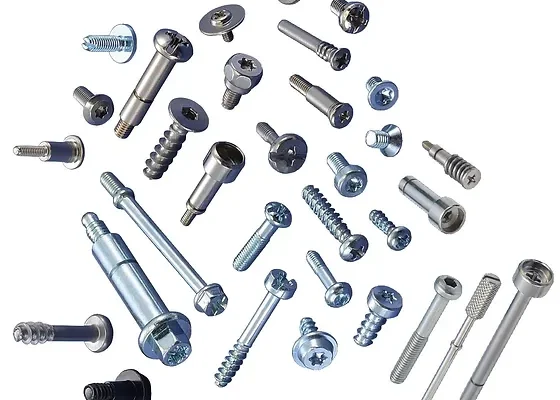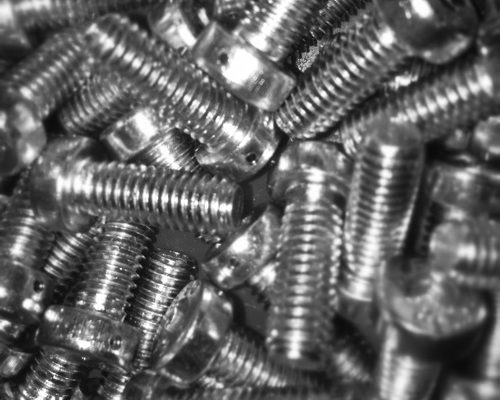
How to differentiate metric and imperial bolts
To differentiate metric and imperial bolts, check the thread pitch. Metric bolts are measured in millimeters, e.g., M8×1.25, while imperial bolts use Threads Per Inch (TPI), like 1/4″-20 with a pitch of 20 TPI (1.27 mm).
Screw pitch
Pitch refers to the distance between adjacent threads, which is expressed in a completely different way in metric and imperial bolts. In metric bolts, the pitch is measured in millimeters, with M10×1.5 indicating that the bolt has a diameter of 10 millimeters, a pitch of 1.5 millimeters, and a distance between threads of 1.5 millimeters. Common metric bolt pitches range from 0.5 mm to 2.5 mm. The common pitch of the M8 bolt is 1.25 mm, while the pitch of the M6 bolt is 1.0 mm.
The pitch of an Inch bolt is indicated by Threads Per Inch (TPI), and a 1/4″-20 bolt indicates a diameter of 1/4 inch and 20 threads per inch. This means that the distance between threads is about 1.27 mm (since 1 inch =25.4 mm, 25.4 divided by 20 gives 1.27 mm). The TPI range of imperial bolts is also very wide, from 10 TPI to 40 TPI. Coarse threaded bolts (UNC, Unified National Coarse) have less TPI, such as 1/2″-13 indicating 13 TPI, while Fine threaded bolts (UNF, Unified National Fine) may reach 24 TPI.
Hand screw an imperial bolt, its thread is wider, feel will feel “looser”, and the metric bolt thread is more tight, the distance between the threads is smaller, screw up will appear “more compact”. Metric bolts are often encountered when repairing bicycles or installing household appliances, especially those made in Europe. On equipment made in the United States, it is more common to use imperial bolts, such as classic American classic car parts.

Bolt head marking
A number is printed on the metric bolt, such as “8.8” and “10.9”. These numbers represent the strength level of the bolt. The first “8” in the “8.8” indicates that the bolt has a tensile strength of 800 MPa, while the second “8” indicates that the yield strength is 80% of the tensile strength, or 640 MPa. Most bolts in the engine compartment of cars made in Europe will have such metric markings.
Inch bolts are indicated by the line on the head of the bolt to indicate its strength level, with 3 lines indicating Class 5 bolts and 6 lines indicating Class 8 bolts. For example, a Class 5 bolt has a tensile strength of about 120,000 pounds per square inch (psi), while a Class 8 bolt has a tensile strength of about 150,000 psi.
If you’re doing a home improvement or car repair, checking the markings on the bolt heads can quickly tell if you’re using metric or imperial bolts. Metric bolts with numerical markings are used when repairing motorcycles, and imperial bolts are more common when repairing an American-made trailer.
For structural components that need to withstand greater pressure, such as steel structural supports, class 8 imperial bolts or class 10.9 metric bolts are good choices. For general mechanical assembly or household appliances, Class 5 imperial bolts or Class 8.8 metric bolts are sufficient.

Dimension mark
In metric bolts, dimension marks are in millimeters, and a bolt labeled “M10×1.5” indicates that the bolt has a diameter of 10 mm and a pitch of 1.5 mm. The “M” stands for metric, and the numbers behind it indicate the diameter and pitch of the bolt. The length of the metric bolt is measured in millimeters, the common length is 20 mm to 100 mm, the diameter of the metric bolt M8 is 8 mm, the common length is 30 mm to 80 mm.
In imperial bolts, the size mark is expressed in inches. Bolts labeled “1/4″-20” indicate that the diameter of the bolt is 1/4 inch and the pitch of the thread is 20 threads per inch (TPI). Unlike metric bolts, imperial bolts provide both diameter and pitch at the time of dimensional marking. The length of imperial bolts is also measured in inches, with common lengths ranging from 1 inch to 6 inches. A bolt labeled “3/8″-16” with a diameter of 3/8 inch and a pitch of 16 TPI is commonly used in industrial equipment, especially in older automobiles made in the United States.
The use of metric bolts requires the use of metric wrenches or sockets such as 10 mm, 12 mm wrenches. Inch bolts require inch tools such as a 1/2-inch or 3/8-inch wrench. Using the wrong tool can cause the bolt to slip and even damage the bolt head.
Install a kitchen appliance from Europe with metric bolt sizes such as M6, M8. When repairing a power tool imported from the United States, the imperial bolt may be marked “1/4″-20”, in which case the imperial tool can be used for accurate installation and removal.
Tool
Metric and inch bolts need to be installed or removed using different tools due to different size marks.
When dealing with metric bolts, the dimensions of the tool are measured in millimeters. Common metric tools include various metric wrenches and sleeves. Tightening the bolts of an M10 requires the use of a 10mm wrench or socket to complete the operation. Metric tools are increments of 2 mm, from 6 mm, 8 mm, 10 mm, 12 mm to larger sizes such as 17 mm and 19 mm.
Inch tools are required for inch bolts, and common tool specifications include 1/4 inch, 3/8 inch, and 1/2 inch. For handling 1/4-inch diameter imperial bolts, the required wrench or socket will be labeled “1/4”.
When repairing an old American muscle car, you’ll find that most of the bolts are imperial, and you’ll need a 1/2-inch wrench to remove and install the tire bolts. The installation of a domestic appliance in daily home maintenance requires the use of a 10 mm or 12 mm metric wrench.
Attempting to unscrew an imperial bolt with a metric wrench can cause the bolt head to slip or wear, affecting its quality and service life. Using imperial tools to deal with metric bolts will also encounter similar problems and even increase the cost of repair.



